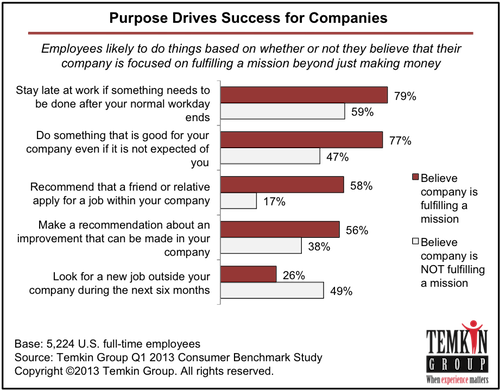PCxD Principle #1: Align Through Purpose
August 20, 2013 Leave a comment
I recently introduced a concept for enlisting the support of employees that uncovers and fulfills the needs of customers that we call People-Centric Experience Design (PCxD), defined as:
Fostering an environment that creates positive, memorable human encounters
Principle #1: Align Through Purpose
Just about every large organization has vision and mission statements floating around their hallways. But when it comes to making decisions on a day-to-day basis, these documents are nowhere to be found. They play NO ROLE in how the company is actually run. But things are different within customer experience leaders.
USAA earned industry-leading scores in credit cards and insurance in the 2011, 2012, and 2013 Temkin Experience Ratings. What makes USAA so special? Here’s what Wayne Peacock, Executive Vice President of Member Experience at USAA, told us:
“We are a mission-driven organization. Everything we talk about is focused on helping military families with their financial security. Everyone in our organization has an intense focus on serving our members. It’s our true “North Star” that allows us to do things differently.”
Southwest Airlines has also led its industry in the previous two years of Temkin Experience Ratings. How does Herb Kelleher, Founder of Southwest Airlines, describe the company’s secret to success?
“If you create an environment where the people truly participate, you don’t need control. They know what needs to be done and they do it. And the more that people will devote themselves to your cause on a voluntary basis, a willing basis, the fewer hierarchies and control mechanisms you need.”
Southwest Airlines and USAA are examples of companies that lead with purpose. Their leaders understand that human beings have a desire to affiliate and being a part of something in which they believe. In Temkin Group’s recent study of more than 5,000 full-time U.S. employees, we found companies that focus on a mission beyond just making money are 80% more likely to be customer experience leaders in large part based on the effort and commitment of their employees.
Here are some ways that companies can master this principle:
- Make the mission personal and central to HR. Companies with a highly engaged workforce often have very clear and well-known mission. To help an organization embrace the mission, it needs to be written, letting people know what’s expected and what’s valued. Tony Hsieh, the CEO of Zappos explained that the company’s 10 core values, that start with “Deliver Wow Through Service” and ends with “Be Humble” are the cornerstone to how he runs the company. He expects hire leaders to hire, fire, and promote people based on how well they live up to and support those values. Every HR activity, from recruiting through releasing of employees, needs to reinforce an organization’s purpose.
- Translate your mission into brand promises. True brands are more than marketing campaigns and advertising slogans. They reflect the promises that the company is committed to deliver to its stakeholders. If your company has a strong purpose, then it should be translated into specific promises that it will make (and keep) to customers, employees, and to the communities in which it operates.
- Lead with why. Most corporate communications focus on “what” and “how,” telling people what needs to be done and how they should accomplish it. This command and control pattern may elicit short-term compliance, but it’s efficacy decays quickly and it loses value completely when situations change and the “how” no longer applies. Leaders need to elicit buy-in from people by starting communications with “why,” explaining the reason that something is important to the company and to the people who are being asked to do something. To fully empower people, share “why” a goal is important and “what” success looks like and leave it up to the individuals to figure out “how” to make it happen.
- Focus on intrinsic rewards. Companies often try and force employees into doing things by slapping on metrics and measurements. While these types of extrinsic rewards can change some behaviors, they can often cause conflicts and lead to unexpected consequences. When Staples put in place a goal for $200 of add-ons per computer sold, some store employees stopped selling computers to customers who didn’t want to purchase add-ons. It turns out that people tend to be more motivated by intrinsic rewards. To build commitment from employees, stop piling on extrinsic rewards and focus on providing them with the sense of meaningfulness, choice, competence, and progress. These types of rewards build an emotional, instead of a transactional, commitment from employees.
- Act consistently. Memos from the executive team and proclamations at quarterly meetings do not define what’s important to an organization. An organization’s true purpose is more than words. It needs to show up in every decision that the company makes. Employees can tell what’s really important by looking at what decisions executives make and how they spend their time. If execs want to lead with purpose, then they need to make sure that they act consistently with what they say is important. Corey Booker, Mayor of Newark, once shared this advice that he follows: “My mom used to say that who you are speaks so loudly that I can’t hear what you say.” Remember, you can’t fake it.
The bottom line: Inspire loyalty and alignment by tapping into the power of purpose.

